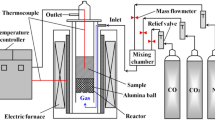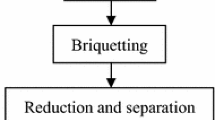Abstract
With the increasing demand for low-carbon metallurgy, large-scale hydrogen-rich smelting has become an effective way to realize low-carbon ironmaking. The injection of hydrogen-rich fuel into blast furnace changed the reduced atmosphere, affecting the reaction behavior and structure of the burden. Production practice has proved that the use of nut coke is an important measure for alleviating the increasingly tense relationship between coke supply and realizing low reducing agent ironmaking. In this paper, the effect of mixed charging of nut coke and sinter on reduction and softening-melting properties in the hydrogen-rich smelting process of blast furnace is studied. The results showed that the close contact between nut coke and sinter promoted carbon dissolution and water–gas reaction to generate more CO and H2, thus increasing the reduction potential in the gas mixture. With the increase of nut coke and hydrogen-rich ratio, the softening–melting properties of the burden were improved. This change narrowed and lowered down the position of cohesive zone, triggering to an enlargement of indirect reduction zone, which was conducive to strengthening blast-furnace smelting and saving coke. The permeability resistance of the burden bed was reduced, which was beneficial to the good airflow distribution and the gas utilization rate. There was a slag layer between nut coke and metal iron phase in the softening–melting process, and the slag could quickly fuse with the ash distributed on the nut coke surface to dissolve it, thus promoting the occurrence of carburizing reaction and improving the dripping behavior of the burden.
Graphical Abstract












Similar content being viewed by others
References
Ma KH, Deng JY, Wang G, Zhou Q, Xu J (2021) Utilization and impacts of hydrogen in the ironmaking processes: a review from lab-scale basics to industrial practices. Int J Hydrogen Energy 46:26646–26664. https://doi.org/10.1016/j.ijhydene.2021.05.095
Zhang B, Guo JZ, Zhang HW, Mao JJ, Li QJ, Wang DY, Hong X (2012) Experimental investigation on optimal carbon/hydrogen ratio for developing iron bath reactor with H2-C mixture reduction. Steel Res Int 83:175–180. https://doi.org/10.1002/srin.201100201
Wang DD, Xu J, Ma KH, Xu Y, Dang J, Kou MY, Lv XW (2017) Innovative evaluation of CO-H2 interaction during gaseous wustite reduction controlled by external gas diffusion. Int J Hydrogen Energy 42:14047–14057. https://doi.org/10.1016/j.ijhydene.2017.04.065
Chen YB, Zuo HB (2021) Review of hydrogen-rich ironmaking technology in blast furnace. Ironmak Steelmak 48:749–768. https://doi.org/10.1080/03019233.2021.1909992
Bilík J, Pustejovska P, Brozova S, Jursova S (2013) Efficiency of hydrogen utilization in reduction processes in ferrous metallurgy. Sci Iran 20:337–342. https://doi.org/10.1016/j.scient.2012.12.028
Chu MS, Guo XZ, Shen FM, Yagi JI (2007) Numerical simulation of innovative ironmaking technologies applied in blast furnace process. J Northeastern Univ 28:829–834
Can Y, Jens W, Thomas T (2017) Modeling and simulation of hydrogen injection into a blast furnace to reduce carbon dioxide emissions. J Clean Prod 154:488–501. https://doi.org/10.1016/j.jclepro.2017.03.162
Elsayed AM, Alexander B, Dieter S (2011) Effect of nut coke-sinter mixture on the blast furnace performance. ISIJ Int 51:350–358. https://doi.org/10.2355/isijinternational.51.350
Kashihara Y, Sawa Y, Sato M (2012) Effect of hydrogen addition on reduction behavior of ore layer mixed with coke. ISIJ Int 52:1979–1985. https://doi.org/10.2355/isijinternational.52.1979
Kashihara Y, Iwai Y, Sato T (2015) Effect of unconsumed mixed small coke on permeability in lower part of blast furnace. ISIJ Int 55:1237–1244. https://doi.org/10.2355/isijinternational.55.1237
Gavel DJ, Adema A, Van Der STELJ (2019) Effect of nut coke addition on physicochemical behaviour of pellet bed in ironmaking blast furnace. ISIJ Int 59:778–786. https://doi.org/10.2355/isijinternational.ISIJINT-2018-580
Chang ZY, Wang P, Zhang JL, Jiao KX, Zhang YQ, Liu ZJ (2018) Effect of CO2 and H2O on gasification dissolution and deep reaction of coke. Int J Min Met Mater 25:1402–1411. https://doi.org/10.1007/s12613-018-1694-4
Nishioka K, Ujisawa Y, Tonomura S (2019) Sustainable aspects of CO2 ultimate reduction in the steelmaking process (COURSE50 Project), Part 1: hydrogen reduction in the blast furnace. J Sustain Metall 2:200–208. https://doi.org/10.1007/s40831-016-0061-9
Tang J, Chu MS, Li F, Feng C, Liu ZG, Zhou YS (2020) Development and progress on hydrogen metallurgy. Int J Min Met Mater 27:713–723. https://doi.org/10.1007/s12613-020-2021-4
Liu YL, Wang JS, Zhang HJ, Liu JL, She XF, Xue QG (2015) Reduction behaviour of ferrous burden under simulated oxygen blast furnace conditions. Ironmak Steelmak 42:358–365. https://doi.org/10.1179/1743281214Y.0000000238
Bai MH, Long H, Ren SB, Liu D, Zhao CF (2018) Reduction behavior and kinetics of iron ore pellets under H2–N2 atmosphere. ISIJ Int 58:1034–1041. https://doi.org/10.2355/isijinternational.ISIJINT-2017-739
An XW, Wang JS, Lan RZ, Han YH, Xue QG (2013) Softening and melting behavior of mixed burden for oxygen blast furnace. J Iron Steel Res Int 20:11–16. https://doi.org/10.1016/S1006-706X(13)60090-4
Wang HT, Zhao W, Chu MS, Wang R, Liu ZG (2017) Effect and function mechanism of sinter basicity on softening-melting behaviors of mixed burden made from chromium-bearing vanadium-titanium magnetite. J Cent South Univ 24:39–47. https://doi.org/10.1007/s11771-017-3406-z
Wang HT, Chu MS, Wang ZH, Zhao W, Liu ZG, Tang J (2018) Research on the post-reaction strength of iron coke hot briquette under different conditions. JOM 70:1929–1936. https://doi.org/10.1007/s11837-018-3036-4
Bernasowski M (2014) Theoretical study of the hydrogen influence on iron oxides reduction at the blast furnace process. Steel Res Int 85:670–678. https://doi.org/10.1002/srin.201300141
Lu F, Wen LY, Zhao Y, Zhong H, Xu J, Zhang SF (2019) The competitive adsorption behavior of CO and H2 molecules on FeO surface in the reduction process. Int J Hydrogen Energy 44:6427–6436. https://doi.org/10.1016/j.ijhydene.2019.01.173
Natsui S, Shibasaki R, Kon T, Ueda S (2013) Effect of high reactivity coke for mixed charge in ore layer on reaction behavior of each particle in blast furnace. ISIJ Int 53:1770–1778. https://doi.org/10.2355/isijinternational.53.1770
Mousa EA, Senk D, Babich A (2010) Influence of nut coke on iron ore sinter reducibility under simulated blast furnace conditions. Ironmak Steelmak 37:219–228. https://doi.org/10.1179/030192309X12506804200906
Qie Y, Lyu Q, Liu XJ, Li JP, Lan CC, Zhang SH, Yan CJ (2018) Effect of hydrogen addition on softening and melting reduction behaviors of ferrous burden in gas-injection blast furnace. Metall Mater Trans B 49:2622–2632. https://doi.org/10.1007/s11663-018-1299-3
Lan CC, Zhang SH, Liu XJ, Lyu Q (2020) Change and mechanism analysis of the softening-melting behavior of the iron-bearing burden in a hydrogen-rich blast furnace. Int J Hydrogen Energ 45:14255–14265. https://doi.org/10.1016/j.ijhydene.2020.03.143
Pan YZ, Zuo HB, Wang JS, Xue QG, Wang G (2020) Review on improving gas permeability of blast furnace. J Iron Steel Res Int 27:121–131. https://doi.org/10.1007/s42243-019-00321-y
Du CB, Liu ZJ, Zhang JL, Wang YZ, Niu LL (2018) Effect of hydrogen content on reduction and softening-melting properties of iron bearing charges. China Metallurgy 28:19–23. https://doi.org/10.13228/j.boyuan.issn1006-9356.20180158
Ueda S, Kon T, Miki T, Kim SJ, Nogami H (2016) Effects of Al2O3 and MgO on softening, melting, and permeation properties of CaO-FeO-SiO2 on a coke bed. Metall Mater Trans B 47:2371–2377. https://doi.org/10.1007/s11663-016-0683-0
Liu Y, Xue Q, Guo W (2016) The dynamic dissolution of coke with slag in melting and dropping zone: 7th International Symposium on High-Temperature Metallurgical Processing. Springer
Pan Y, Zuo HB, Wang BX, Wang JS, Wang G, Liu YY (2018) Effect of reduction degree on cohesive zone and permeability of mixed burden. Ironmak Steelmak 47:322–327. https://doi.org/10.1080/03019233.2018.1493762
Shin M, Oh JS, Lee J (2015) Carburization, melting and dripping of iron through coke bed. ISIJ Int 55:2056–2063. https://doi.org/10.2355/isijinternational.ISIJINT-2015-115
Acknowledgements
The authors gratefully acknowledge the financial support from the National Natural Science Foundation of China (U1960205) and China Minmetals Corporation (2020ZXA01).
Author information
Authors and Affiliations
Corresponding author
Ethics declarations
Conflict of interest
The authors declare that they have no conflict of interest.
Additional information
The contributing editor for this article was Veena Sahajwalla.
Publisher's Note
Springer Nature remains neutral with regard to jurisdictional claims in published maps and institutional affiliations.
Rights and permissions
Springer Nature or its licensor (e.g. a society or other partner) holds exclusive rights to this article under a publishing agreement with the author(s) or other rightsholder(s); author self-archiving of the accepted manuscript version of this article is solely governed by the terms of such publishing agreement and applicable law.
About this article
Cite this article
Chen, Y., Yu, Y., Gao, Y. et al. Effect of Mixed Charging of Nut Coke and Sinter on Hydrogen-Rich Smelting Process of Blast Furnace. J. Sustain. Metall. 9, 280–293 (2023). https://doi.org/10.1007/s40831-022-00645-2
Received:
Accepted:
Published:
Issue Date:
DOI: https://doi.org/10.1007/s40831-022-00645-2




